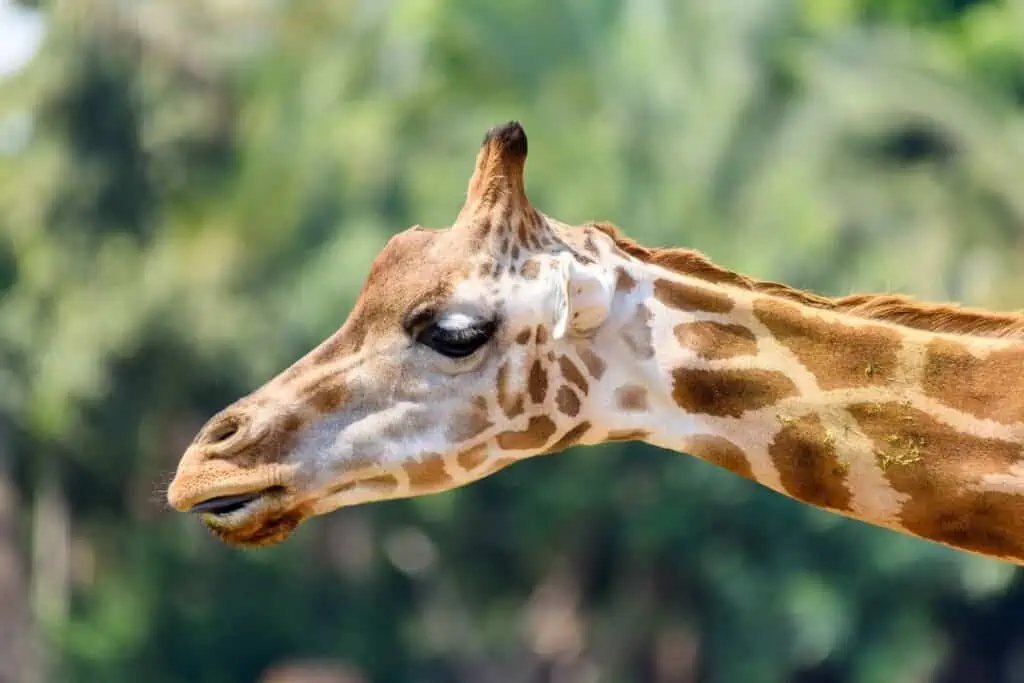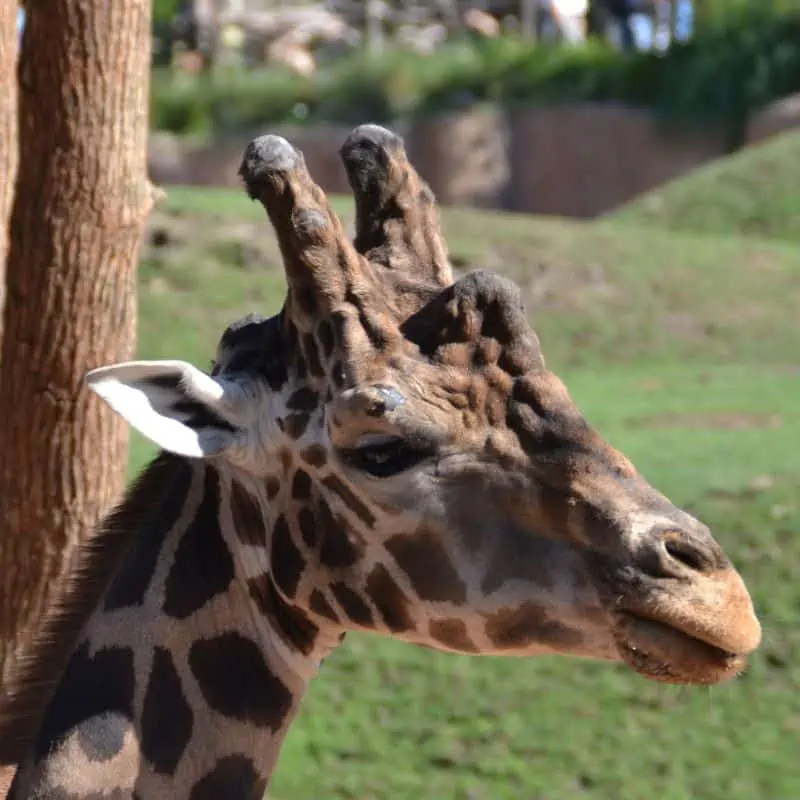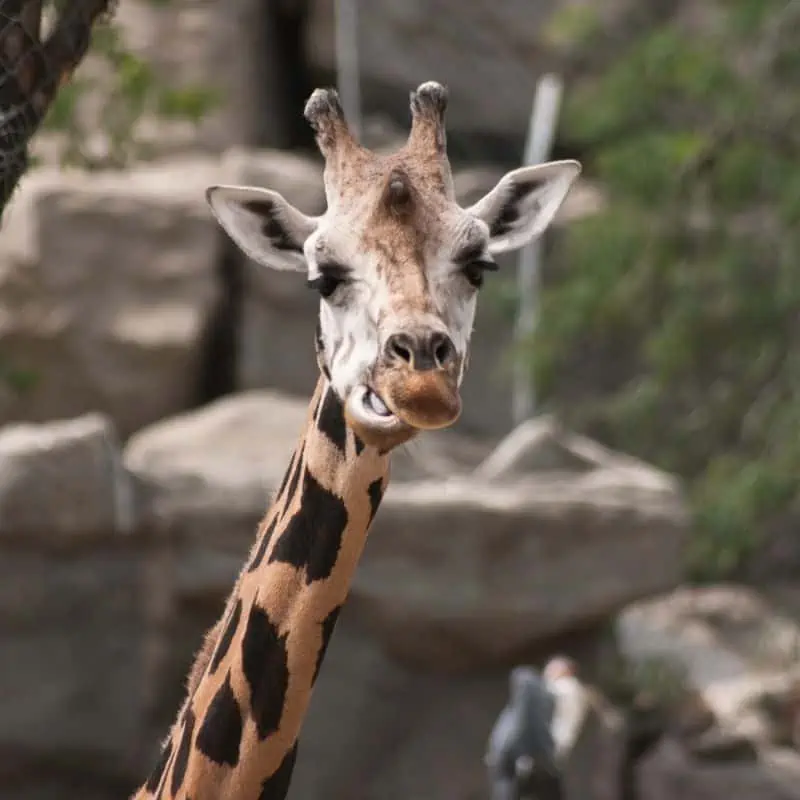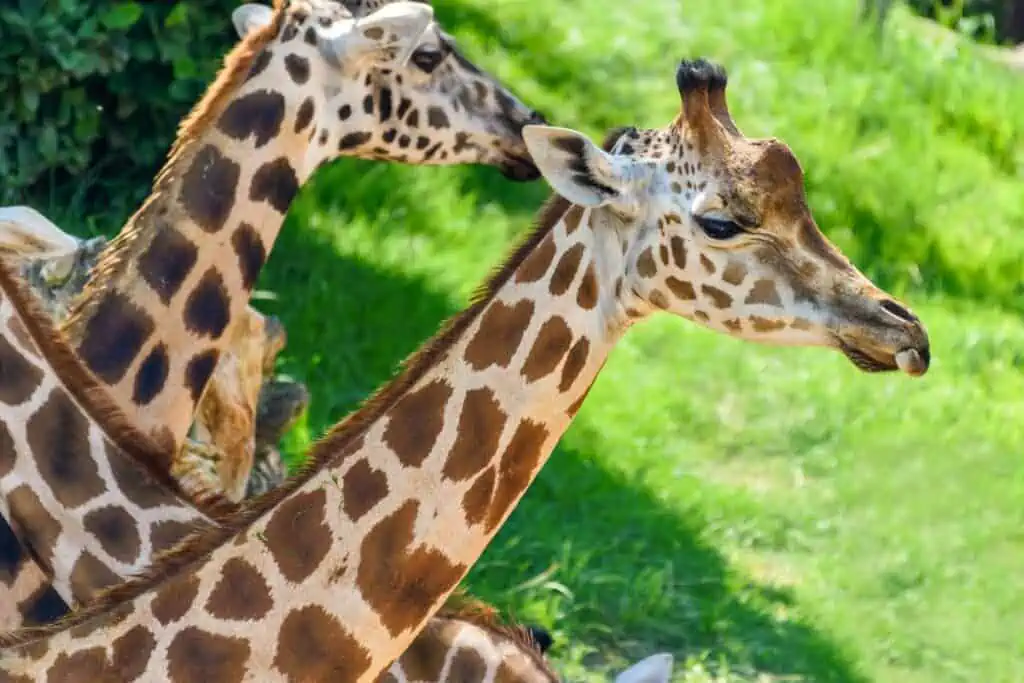There are four different giraffe species (depending on who you ask), and the Northern giraffe is one of the most interesting.
The northern giraffe is the rarest species of giraffe. They originated in north Africa, but their natural habitat range has shrunk, and they are extinct in the region. Now they mainly live in east and central Africa. They are similar to other giraffes, but there are some key differences.
In this article, we’ll look at some interesting northern giraffe facts and learn more about this rare giraffe species.

- 1. Northern giraffes do not have a lot of relatives
- 2. They’re also known as the three-horned giraffe
- 3. They are herbivores
- 4. How Northern giraffes reproduce
- 5. Lions are their main natural predator
- 6. Their natural habitat has shrunk
- 7. They are the most threatened giraffe species
- Final thoughts on Northern giraffes
1. Northern giraffes do not have a lot of relatives
Northern giraffes are one of four giraffe species, and the only living relative to the giraffe is the Okapi, another critically endangered mammal.
The Northern giraffe is comprised of three subspecies:
- Kordofan giraffe
- Nubian giraffe
- West African giraffe
The Kordofan giraffe and Nubian giraffe are critically endangered, with only a couple hundred of each remaining in the wild.
2. They’re also known as the three-horned giraffe
Northern giraffes look pretty similar to Southern giraffes, but there is a distinct difference with their ossicones. The ossicones are the features on a giraffe’s head that look like horns or antlers.
Other types of giraffes have two large ossicones on their head, while the third ossicone is fairly small and hardly noticeable.
Northern bull giraffes, however, have a large third ossicone on the top of their head, just over their eyes. This is a feature that a Southern giraffe does not have and gives them the nickname “three-horned giraffe”.
Northern giraffes also have much larger ossicones than those on a Southern giraffes.
The Rothschild’s giraffe, an ecotype of the Nubian giraffe, which is a subspecies of the Northern giraffe, as mentioned above, actually has five ossicones in total, two of which are smaller and on the back of the head.

3. They are herbivores
Like the rest of their family, northern giraffes are herbivores. This means that they only eat plants. This is why they have such long necks to reach the fruit at the tops of the trees.
Northern giraffes eat a diet that typically consists of plants such as leaves, fruits, flowers, and parts of woody plants. They prefer to eat leafy greens, but they are known to chew bark when they are anxious.
They are also known sometimes to lick corpses to absorb calcium from bones.
Northern Giraffes also have a complicated digestive system. They have strong muscles in their throat because their food has to travel down from their mouth to their stomach.
They also have to be able to regurgitate food back up from their mouth to their stomach as they’re ruminants.
4. How Northern giraffes reproduce
Reproduction in northern giraffes happens between large males and fertile females. They are known to test mating potential by sniffing each other and testing their urine.
When Northern giraffes reproduce, the courtship process involves physical contact with their ossicones and head and licking each other.
When a female Northern giraffe gives birth, she stays standing. That is right. When baby giraffes are born, they fall six feet onto the ground.
It takes a few hours, but the baby giraffe usually learns to stand up and take their first steps within a couple of hours of being born.
Baby giraffes must learn how to stand up and walk on their own quickly. If they do not, they become vulnerable to being eaten by one of their natural predators.
5. Lions are their main natural predator
Northern giraffes protect themselves and their young from predators using their legs as weapons. Giraffes have powerful leg muscles, and a well-timed kick to the head of a predator can incapacitate or even kill.
However, Northern giraffes are generally docile creatures, and they will not strike unless they are stressed out.
Because it is very difficult and dangerous for predators to take down a healthy Northern giraffe, they are usually not the first choice for carnivores looking for a meal.
When the less dangerous prey that is easier to catch is nowhere to be found, the predators come for the giraffes.
The main predator that northern giraffes have to worry about are lions. Lions will sneak up on a group of giraffes and look for the youngest and weakest of them. They will also look for pregnant female giraffes who are about to give birth because the pregnant giraffes can’t move as quickly.
Giraffes are most vulnerable to attack when they are drinking water. They have to stop and expose their neck by bending over to drink. This is also when giraffes are exposed to their other primary predator: crocodiles.
It is common for crocodiles to leap out of the water and attack a giraffe while it is drinking. This is enough to knock the giraffe over and let the crocodile pull it into the water to kill and eat it.
Giraffes avoid this by always taking turns when they drink water while the others stand and keep watch.

6. Their natural habitat has shrunk
Northern giraffes used to be widespread across north and west Africa. However, there have been many local extinctions of giraffes over the centuries, and their range has shrunk dramatically.
They are the least common giraffe species, even though they used to be one of the most abundant animals in North Africa.
Over thousands of years, the climate has changed, and the Sahara has become a desert. These dry conditions killed the Northern giraffes in the region, driving them to extinction.
Northern giraffes sometimes live in east Africa, particularly in Kenya and southwestern Ethiopia. There are still isolated pockets of Northern giraffes throughout other parts of central Africa, such as in Chad, Cameroon, and the Central African Republic.
In addition to charcoal farming, the habitat of these giraffes is constantly shrinking.
7. They are the most threatened giraffe species
Giraffes are considered a threatened species, and northern giraffes are the most endangered type of giraffe.
The Nubian giraffe, in particular, only has a couple of hundred mature adults in the wild.
Giraffes are undergoing a silent extinction; this is the slow decline of an animal population that doesn’t draw much attention as they “only” decrease by a small percent each year.
With constant decreases, however, this can lead to a serious problem, becoming apparent with Northern giraffes’ subspecies.

Final thoughts on Northern giraffes
The northern giraffe is the most threatened of all the giraffe species. Their numbers are dwindling, and their natural habitat is shrinking.
This puts them in danger of extinction if something isn’t done soon to help protect them.
Northern giraffes are an essential part of the African ecosystem, and it would be a shame to lose them forever. We need to do more to raise awareness about these gentle giants and their plight before it’s too late.

